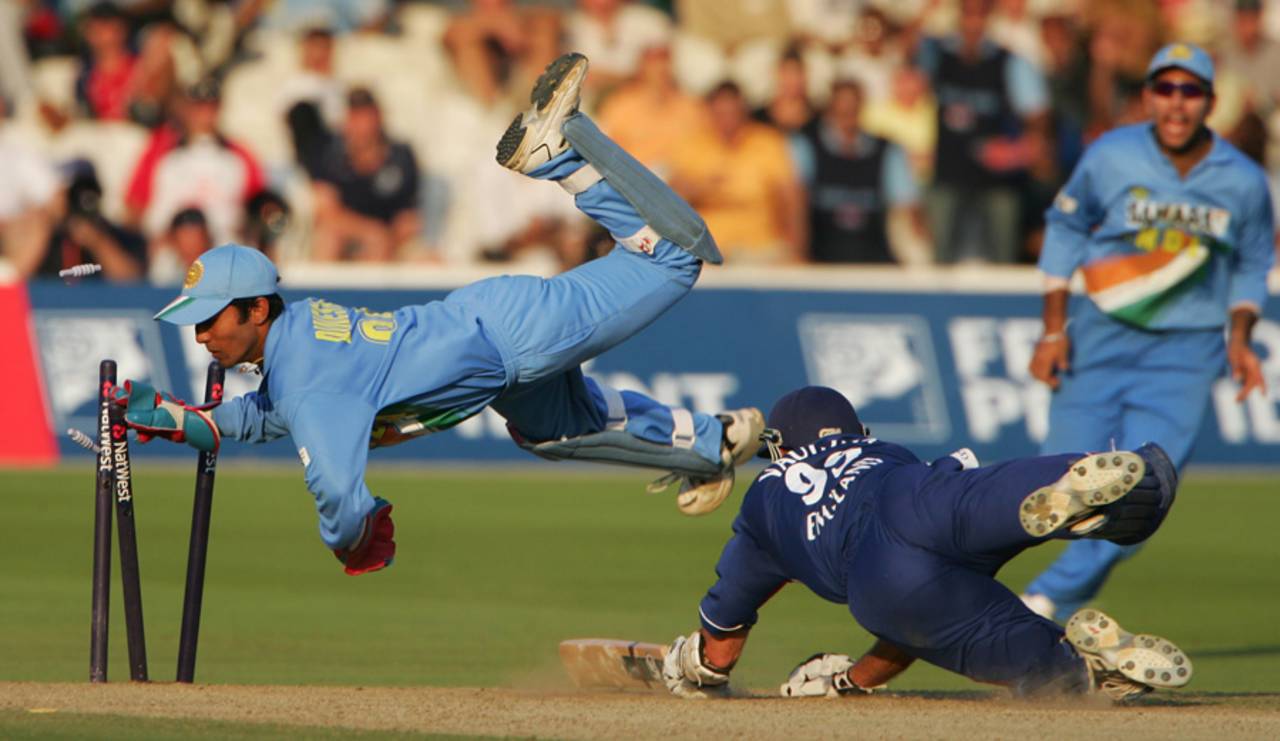The photographs of India wicketkeeper
Dinesh Karthik diving and stumping England's Michael Vaughan were taken on September 5, 2004,
at Lord's during a one-day series.
The shots were taken with a Canon body with a 500mm lens and a 1.4 teleconverter. I had in 2004 changed to Canon equipment as I believed Canon had overtaken Nikon with their range of digital cameras. In 2008 Nikon overtook Canon again and I changed back. Both very expensive decisions for me! Anyway Nikon and Canon both make great cameras and lenses while both charge thousands of pounds for most items. I would estimate that well over 99% of professional photographers who turn up at sporting events use one of these two brands. I still question how a 600mm telephoto lens, which is basically just some metal and some glass can cost the same as a brand new car. Answers on a post card please. (No, I'm not going to be diverted again and explain what a post card is.)
Photographers are very well treated at Lord's and normally have a large choice of positions from where they can photograph major matches. Usually I sit at the Nursery End of the ground underneath the media centre but occasionally I may choose one of two positions beside the famous Lord's pavilion.
On this day I chose to sit in the gap between the pavilion and the Warner stand. There were quite a few good photographs to be had that day if I remember correctly. In the 44th over of England's chase of 205 Ashley Giles was caught and bowled by Harbhajan Singh. A couple of photographers near me "downed tools", picked up their laptops and started to load and caption images of that wicket and celebration.
Photographers really should be able to transmit their cricket pictures without missing a single ball. That's one reason why I prefer to use a tripod that holds the lens and camera in place in front of me even when I'm busy on a laptop. I can lean forward as every ball is bowled and I'm ready to capture any incident that may take place. A lot of photographers who use a monopod will put their camera/lens/monopod down on the ground and start working on their laptop. If something happens they'll need a few seconds to pick up their equipment.
Anyway, five balls after Giles was dismissed… oh, hang on a minute. I know this has nothing to do with anything, but really like the story about the Warwickshire club shop ordering some "Ashley Giles, King of Spin" drinking mugs. When the mugs were unpacked it was obvious that the printer had blundered as they actually had "Ashley Giles, King of Spain" on them. Sorry about that, I'm back.
As I was saying, exactly five balls after Giles was caught, Harbhajan bowled a very wide ball down the leg side and Vaughan left his crease, wafted his bat at the ball and had to turn around and quickly attempt to get back into his ground. Karthik impressively collected the ball and stretched for the stumps, managing to dislodge the bails just before Vaughan got his bat back over the line. There was a brief delay before the third umpire confirmed that Vaughan was out.
Now the thing is that this photograph would have been fairly worthless if Vaughan had made it back into his crease but as he was dismissed it really summed up the match and India's victory.
A friend of mine and fellow photographer David Davies, who was shooting from the Nursery End of the ground also captured the very same moment. He is known around the globe as "Wavy Davy". I've known him 20 years but never bothered to ask why. It's an odd nickname come to think of it. I'll ask him about it next time I see him.
The point is it is most unusual for a moment like this to make a good picture for two photographers sitting at basically opposite ends of the ground. "Wavy" can in fact be seen in my photograph as a higher bail is right in line with him.
I was quite lucky to get the shot as I was shooting landscape at that time rather than upright. No matter how skilful you might be you have to have a little luck to capture your share of good photos. I do remember a bit of a scramble as some of the photographers who had "downed tools" rushed over demanding to view the stumping photographs that they had missed. They weren't happy when they saw the sequence. In the sequence there is an obvious frame that stands out as the best one to send. I've included the sequence just to illustrate how many pictures can be captured in a short space of time. The Canon camera body I used that day took approximately 5 or 6 frames a second. That was nearly eight years ago, cameras have moved on at pace and my most recent camera body, a Nikon D4 takes about eleven frames a second.
It was Karthik's first match for India. What a way to start a career. He was just 19 and apparently inspired the number one hit song by Paul Hardcastle.
Specifications: Canon EOS - 1D MkII, Canon 500mm f4 lens, 1.4 teleconverter, ISO 250, aperture 6.3, 1/1000th
An Australian freelance cricket photographer based in England, Philip Brown has photographed over 150 Test matches around the world

